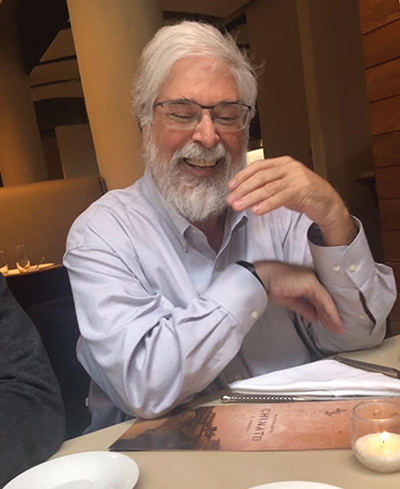"The Dickensian Reader as Detective"
July 6, 2020
Friends of the Dickens Project Board Member and filmmaker, Michael Stern, discusses how the uncovering of connections between seemingly unconnected places and people in Bleak House can help us to understand societal epidemics.
VIDEO TRANSCRIPT
Hi, I'm Mike Stern with a favorite passage from Dickens that we're sharing as part of the Dickens Project's Dickens-to-Go series. The passage is from Bleak House. It's a short one from near the beginning of chapter 16. The third-person narrator starts off describing Lady Dedlock's ennui at Chesney Wold and her London townhouse, then segways to a description of Tom-All-Alone’s. That's the ruined street caught up in the endless Chancery suit of Jarndyce versus Jarndyce where Jo, the crossing sweeper lives.Here's the passage. "What connexion can there be between the place in Lincolnshire, the house in town, the Mercury in powder, and the whereabout of Jo the outlaw with the broom, who had the distant ray of light upon him, when he swept the churchyard-step? What connexion can there have been between many people in the innumerable histories of the world who from opposite sides of great gulfs have, nevertheless, been very curiously brought together!”
One of the key formal innovations of Bleak House is its dual-narrative structure. The story alternates between the sardonic, knowing voice of the third-person narrator and the innocent, uninformed, first-person voice of Esther Summerson. The other triumph of form is its pioneering invention of the roman policier. Bleak House is a detective story in many senses. There's the whodunit part, of course—who killed Tulkinghorn—with the relentless Inspector Bucket solving that mystery, an inaugural police procedural, but there are many more mysteries in the novel. Who was Nemo? Why does his handwriting startle Lady Dedlock? What is the meaning of the documents that Krook finds in his rag-and-bottle-shop inventory and haltingly spells out one letter at a time? How is George, the fencing master, related to Mrs. Rouncewell, the housekeeper at Chesney Wold? What's going on in Mr. Snagby's shop and in Cook’s court? What is the secret of Esther's past? And above all, as our passage asks, what is the connection between the many seemingly unconnected places and people in the teeming world of the novel?
The promise of the detective story is intelligibility. What at first is unknown, confused, or deceptive, is learned and decoded. Seemingly unrelated facts and events become clues. Clues then point to a solution. And the mystery is eventually solved. The social order endangered by crime is restored.
This promise is both fulfilled and denied in Bleak House. As readers, we are detectives, too, learning as we go along. We start out befuddled, like Mr. Snagsby or Jo, who is in, "utter darkness as to the meaning of those mysterious symbols”—that is, writing—that surround him. As the story progresses, we learn how the many characters in the novel are indeed connected. Esther is Lady Dedlock's illegitimate daughter. Nemo is her father. George is Mrs. Rouncewell's prodigal son. Krook's documents are Tom Jarndyce's real will. And Hortense killed Tulkinghorn.
But Dickens wants to teach us much more than how to solve a murder mystery. The ultimate connection between "the place Lincolnshire, the house in town, the Mercury in powder, and the whereabout of Jo, the outlaw with the broom" is the dual epidemics that also structure the novel and which make it so resonant in our own pandemic times. The smallpox that originates in Tom-All-Alone's and spreads its death-dealing miasma throughout England is the tangible embodiment of the moral plague of greed and heartlessness that also besets English society. And for this, there is no neat solution. The ray of light that falls from heaven onto Jo in this fallen world cannot overcome the smoke and fog permeating London in the novel's masterful opening passage, which presages the death of the son itself. Esther and Allan Woodcourt must retire from the fallen world to the new Bleak House just to survive, while the telescopic philanthropists, right reverends and wrong reverends, arrogant young snobs, lawyers and Chancery clerks, vain aristocrats, ruthless landlords, and hard-hearted workhouse masters fret and chafe and make their usual uproar. For this knowledge, there is no forgiveness and there is no answer.
 Michael Stern has been a devoted attendee of Dickens Universe since 2012. He helped establish the Jordan-Stern Presidential Chair for Dickens and Nineteenth-Century Studies, and now serves on the Friends of the Dickens Project Board. Stern practiced law in Silicon Valley from the 1980s until his retirement in 2018. His enthusiasm for storytelling fed General Magic, a documentary film about the company for which he served as general counsel in the 1990s. The film spotlights the company's triumphs and failures as it marketed the precursor to the smartphone. It opened in theaters nationwide last May.
Michael Stern has been a devoted attendee of Dickens Universe since 2012. He helped establish the Jordan-Stern Presidential Chair for Dickens and Nineteenth-Century Studies, and now serves on the Friends of the Dickens Project Board. Stern practiced law in Silicon Valley from the 1980s until his retirement in 2018. His enthusiasm for storytelling fed General Magic, a documentary film about the company for which he served as general counsel in the 1990s. The film spotlights the company's triumphs and failures as it marketed the precursor to the smartphone. It opened in theaters nationwide last May.
Dickens-to-Go is a weekly program of short videos designed to whet the viewers' appetite for "more" of their favorite author. You can join Dickens Project faculty, friends, and students as they share a favorite passage from Dickens and say a few words about why they selected it.
What are your favorite passages? We hope you will make a video too! Email Courtney Mahaney for video submission guidelines.
